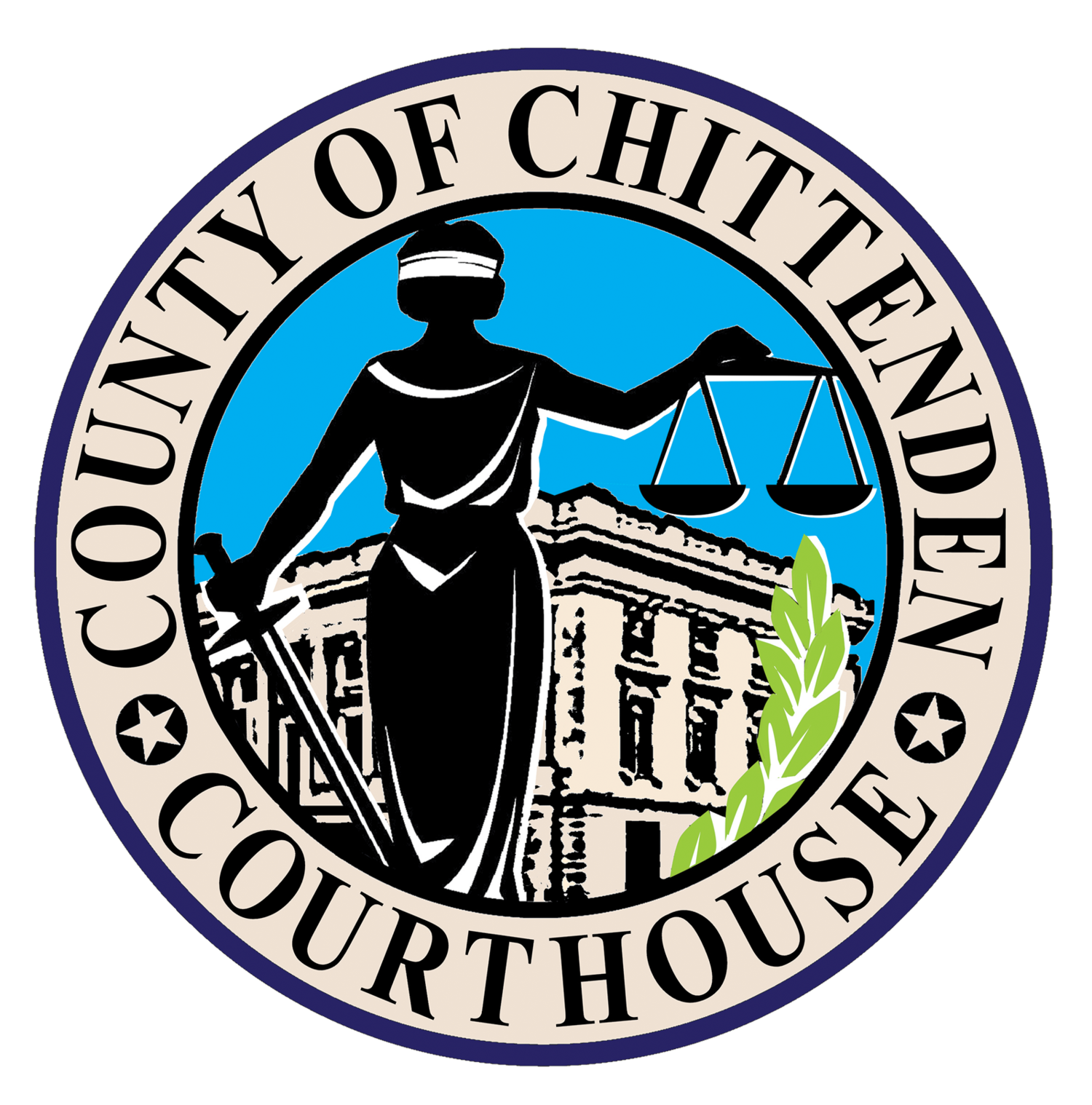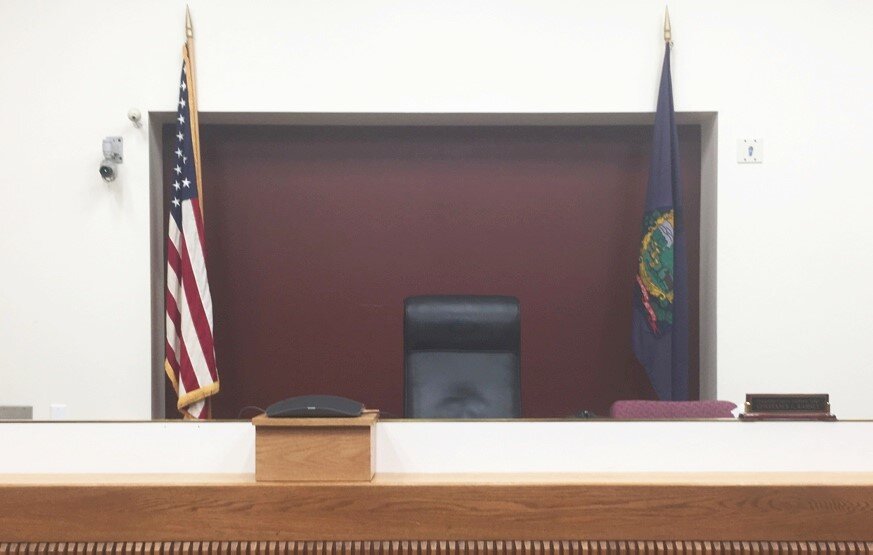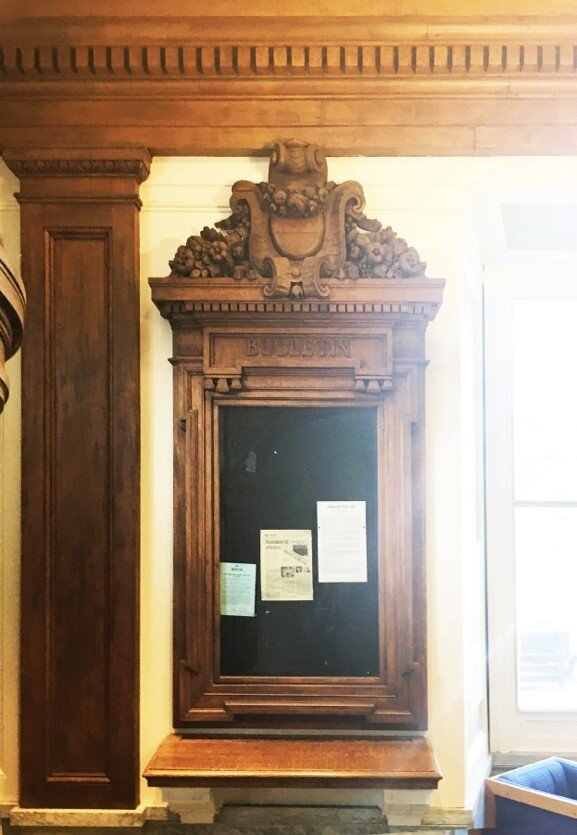Chittenden County Courthouse History
by Connie Cain Ramsey
Courtesy Special Collections, University of Vermont
This 1910 hand colored photo shows; to the right, the redstone courthouse that served Chittenden County for over one hundred years. To its left is the present marble courthouse, formerly the U. S. Post Office and Customs House.
Disorder in the court
In 1971, the Chittenden County Courthouse was as much a fossil as the fossils embedded in the Isle La Motte blue-grey stone that trimmed the classic Redstone block walls of the century-old Burlington landmark.
But the sturdy exterior masked the decay inside. Only two floors were usable, and the third, with bedrooms for sequestered jurors, had neither heat nor water. To add to its troubles, the city of Burlington had demanded a “fire and wire” upgrade estimated at $115,000. Even more importantly, the county had simply outgrown its courthouse space.
Deputy Clerk Cashman Takes the Reins
Courtesy Gillian Randall
At that time, Attorney Ed Cashman, a recent Viet Nam veteran, was offered the position of Deputy County Clerk of Chittenden County where he served for a year before becoming the County Clerk in 1973. (He later become a State’s Attorney and a Vermont Superior Court Judge.)
Shortly after accepting, Cashman saw the need to solve the problem of a crumbling courthouse. He became the major catalyst in bringing together a committee to work towards a plan to usher in a new County Courthouse.
The effort would take over three and a half years of ups and downs, but eventually Ed Cashman and his committee would prevail.
Act 230 - Courting a New Courthouse
Chittenden County contracted a Boston law firm to write a bulletproof bill mandating a new courthouse search to be introduced to the 1972 state legislature. The result was Act 230.
After its passing, a thirteen-member committee, headed by then Probate Judge L. John Cain, was formed to proceed with the search. Judge Cashman fondly remembers the committee minority members whom he felt did the heavy lifting, including: C. Harry Behny, head of the Chamber of Commerce; Attorneys James Murdoch, John Dinse, and John Fitzpatrick; and his own father-in-law, former Superior Court Judge and Supreme Court Justice Harold Sylvester.
The committee considered several replacement options, eventually focusing on the former Customs House and Post Office next door to the County Courthouse on Main Street. It was under-utilized and in need of repair, but had the potential to be converted to a new courthouse. It could be renovated at $27 per square foot versus $45 per square foot for a new building. Not only did the old post office building have parking and room to grow, it was a strikingly beautiful marble building designed by James Knox Taylor, the architect of the U.S. Treasury building in Washington, D.C.
Members of the committee, including Cashman, county Bar Association President David Jenkins and T. Wesley Grady of the Planning Committee, took a trip to Bangor, Maine, in Penobscot County (a city similar in size to Burlington), noted for its experience in renovating and repurposing old buildings for public use. They toured the Bangor City Hall, a former federal building, and the District Courthouse, formerly an A & P grocery store. All renovations had been contracted out to local firms. The members of the committee returned to Vermont convinced that working with the government to renovate the old customs house and post office was the best plan.
The Rocky Road to Raising Revenue
To move forward, the committee requested a bond issuance of 1.4 million dollars to be presented to Chittenden County voters in 1973. It failed to pass. A confluence of negative situations in the eyes of the voters combined to defeat the bond.
First of all, some Chittenden County towns were soured by a Grand List tax levied annually to raise funds for County Courthouse and Sheriff’s Department operations’ expenses. The tax was flexible, averaging under .5 cents per year, with a ceiling of 5 cents. Although legally mandated by the State, the towns felt that they should have a say in any increase, citing that the tax was “undemocratic,” and calling for lawyers to fund the new courthouse. “Do doctors pay for hospitals,” was the Courthouse Committee’s response.
Secondly, the proposal to renovate the old Customs House and Post Office had a very high-profile critic – Vermont Superior Court Judge Robert Larrow (who went on to become a Vermont Supreme Court Justice).
Larrow argued that the committee had been “peddling misinformation through the use of inaccurate press releases” (although no press release had been issued), and complained that the committee had failed to look at alternate locations (although five alternates had been made public). He called the proposed new courthouse a “white elephant,” saying: “at 32,000 square feet it was too big for a courthouse.” Then State’s Attorney Patrick Leahy responded that all unused space would be rented out.
However, in 1974, the committee reintroduced the bond issue and found much less opposition. Through a series of well-received town meeting presentations by County Clerk Cashman and the committee, and with an endorsement from the Free Press, Chittenden County voters approved the bond issue. Once the bonds hit the Boston Bond Exchange, they sold out in 30 seconds.
More Conference Rooms Than Courtrooms
In 1974, the federal government moved out of the old customs house and post office. The future tenants were left with a building with burst pipes and a flooded basement.
The Courthouse Committee went to work on a layout designed for judges, lawyers and jury members. There would be more conference rooms than courtrooms because it was felt that most cases were settled in conference rooms. Plans included a third-floor law library and a comfortable lawyers lounge on the second floor. To avoid a battle of the pecking order for office spaces, the most prime space on the second and third floors, the southwest corners, were converted into public restrooms.
Construction management of the renovation was awarded to local construction firm Wright & Morrissey who had bought the former James E. Cashman Construction Company, the builders of Burlington City Hall, Memorial Auditorium and the Burlington Breakwater (James Cashman turned out to be a distant relative of Ed Cashman).
No Dome, but the Red Marble Fireplaces Remain
One of the courthouse’s Vermont Red Marble fireplaces as it stands today.
Plans to remove all of the Vermont Red Marble fireplaces were scrapped, and thankfully they remain a beautiful tribute to the architecture of earlier times. Looking back, Judge Cashman admits to some design shortcomings. Some judges wanted reclining chairs on the bench, but there was no room behind them, and the benches had already been fastened into the 18-inch thick cement floors.
Another Judge Cashman regret is that money ran out before a roof dome could be constructed on top of the courthouse. This dome had been proposed in the original building plans in 1907, but ironically, the federal government’s appropriation of funds also ran out before it could be built. The twice nearly completed dome frame is still visible in the courthouse attic.
Areas were cut out behind the benches to allow the judges more room.
The original plans for construction of the building included a roof and dome.
Judge Cashman points out the beauty of the carved oak woodwork.
Plaque that is on the building listing the Courthouse Committee members.
Chittenden County’s Past Courthouses
Courtesy Special Collections, University of Vermont
1859 photo of City Hall Park.
1. The First Courthouse is Built in the Center of City Hall Park in 1797.
The county's first court session was held in 1788 at the home of war hero Ira Allen, (where The Winooski Block stands today), in a section of Colchester called Winooski Falls (which later became the city of Winooski). Colchester was declared the county's “Shire Town”.
Two years later, in 1790, Burlington was named the new Shire Town of Chittenden County, and court was held at Gideon King's Tavern. That building is still standing at 35 King Street.
By 1797, the citizens of Chittenden County felt the need for a courthouse solely dedicated to the ministrations of justice. The first courthouse was built in the center of Courthouse Square (now City Hall Park) and served the county until 1801.
2. The Second Courthouse was built in 1801, on the west side of Church Street, where City Hall is now.
The first courthouse was razed just four years after its construction to make way for a facility large enough to also host the Vermont State legislature (who subsequently moved to Montpelier in 1805). A fire destroyed this courthouse in 1828 and it was promptly replaced in the same spot by a third courthouse.
(Unfortunately, I could not find a photo of the first or second courthouses.)
3. The Third Courthouse was built in 1828 in the same spot as the second.
Courtesy Special Collections, University of Vermont
This third courthouse served the county for forty-five years until 1873 when it became the Fletcher Free Library. (left)
Burlington built its Town Hall next to the courthouse in 1854. (right)
Courtesy Special Collections, University of Vermont
This third courthouse served the county for forty-five years until 1873 when it became the Fletcher Free Library. (left)
Burlington built its Town Hall next to the courthouse in 1854. (right)
4. The Fourth Courthouse was built 1n 1872, further down Church Street on the east side.
Courtesy Special Collections, University of Vermont
The above 1926 photo is of the foundations being dug during the construction of City Hall, where Town Hall and the old Courthouse/Library used to be. The fourth and present courthouses can both be seen in the background to the left.
Courtesy Special Collections, University of Vermont
This Vermont courthouse was made out of cut and hammered Redstone and trimmed in blue-grey Isle La Motte stone. This courthouse served Chittenden County for over 100 years. It was placed on the National Historical Registry in 1972, and was lost in a tragic fire in 1982. The land now serves as a parking lot for the current courthouse.
Courtesy Kevin McLaughlin
This aerial photo shows the smoky, smoldering remains of the fourth courthouse, Note the person standing on the roof of the present courthouse.
Before this courthouse was demolished, the county was able to salvage some of the beautiful black walnut woodwork, including 1000 linear feet of elaborate, deeply carved trim work, the grand staircase railings and newels, two enormous arched front doors, and twenty-five Victorian interior doors, some of which were installed in the Green Mountain Inn in Stowe.
The bell from the 1873 courthouse was also salvaged. It was cast by the Meneely Foundry of Troy, NY and is on display at the current courthouse’s lobby.















